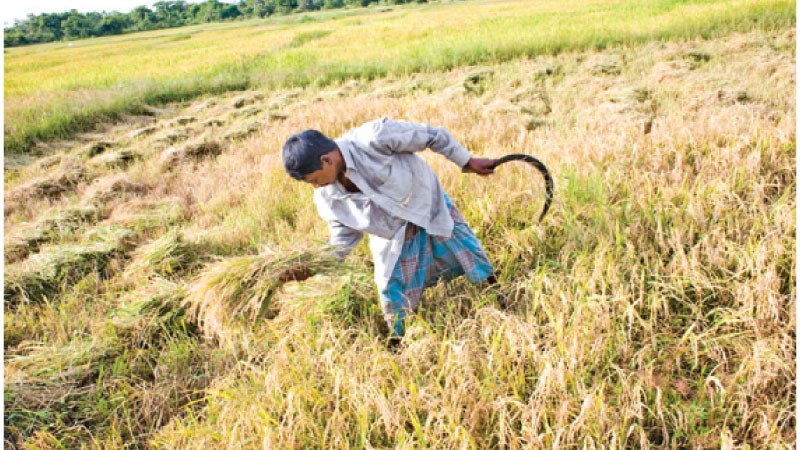“Farmers must be motivated to cultivate to change the perception that farming is a loss-making venture. Young people are not entering the farming sector due to these negative narratives. This is a very pitiful situation,” said a Trotskyist political activist and leader of a farmers’ organisation, Terence Gamini de Silva. He said that the Government should intervene.
The National Farmers’ Movement convened a media conference in Colombo recently to propose a joint program aimed at finding solutions to the problems faced by farmers and the farming industry.
There is a contradiction in land use statistics in Sri Lanka, as reported from time to time by the Central Bank, the Ministry of Plantations, and the Department of Agriculture. The total land area of the country is approximately 6.5 million hectares. Of this, 983,550 hectares is used for paddy cultivation, although 40,356 hectares of that has been abandoned.
According to available data, around 32 percent of the total land area is allocated to agriculture and plantations. When combined with homestead land, which accounts for 18.18 percent, the total amounts to around 50 percent of the country’s land area.
The agricultural sector covers approximately 40 percent of the country’s land area, or around 2.3 million hectares. It also consumes 80 percent of the nation’s water resources. About 27 percent of the national labour force — roughly two million people — is employed in this sector. The total amount of land cultivated for agriculture in Sri Lanka is around 3.3 million hectares. Of this, 45 percent consists of small plots of land less than 0.1 hectare in size. As a result, 3.3 million farmers in Sri Lanka own less than one acre of land. Ninety percent of cultivated land consists of plots smaller than two hectares (around five acres). Eighty percent of the land contributing to the country’s agricultural output is owned by smallholder farmers.
“A guaranteed price for agricultural produce is a global demand”
The South Asian Convener of the International Rural Farmers’ Movement, Vimukthi de Silva said that 70 percent of farmers globally — including those in Sri Lanka — are small-scale farmers. She said that a minimum guaranteed price for agricultural produce is a global demand.
“Farmers expect the Government to regulate prices not only for paddy but also for other supplementary crops. I believe the guaranteed price for paddy in Sri Lanka was determined in a way that benefits producers,” she said.
The Federation of Hambantota District Farmers’ Organisations said that if the Paddy Marketing Board were strengthened and permitted to purchase paddy competitively, there would be no need to import rice. A farmer leader J.H. Munidasa outlined this to journalists in Colombo.
“We demanded Rs. 130 per kilo of Nadu paddy, but the Government offered only Rs. 120. Deputy Minister Namal Karunaratne supported the Rs. 130 price, but decisions were made by a committee that didn’t consult the farmers. As a result, some farmers were tempted to sell their paddy to mill owners who offered Rs. 130. The Paddy Marketing Board could only afford to purchase rice for a single day at Rs. 120. In the end, it’s the farmers who suffer when rice is imported from abroad,” he said.
Export-oriented agriculture projects implemented under the auspices of the World Bank and the Asian Development Bank have failed to meet the health and nutritional needs of the people of this country. These projects have, in many cases, turned farmers into mere agricultural labourers on their own land. The country has been unable to produce the 65,000 metric tons of rice needed for daily consumption. As a result, every Government has been tempted to resort to rice imports as a solution.
“Like previous Governments, this one too is embracing and attempting to implement neo-liberal economic policies. Export-oriented agriculture has been largely unsuccessful.
You cannot build a sustainable agricultural industry based solely on decisions made within the framework of trade agreements. What the country needs is a new vision for agriculture,” said Vimukthi de Silva, emphasising the importance of developing an independent and locally driven agricultural model.
“According to reports from 2014, the malnutrition rate in Sri Lanka stands at 30 percent. We must adopt alternative agricultural practices focused on producing food that meets the nutritional and health needs of our communities to overcome this crisis,” she added.
The majority of Sri Lanka’s agricultural land is dedicated to paddy cultivation. However, compared to countries such as China, Australia, and Indonesia, Sri Lanka’s paddy production remains unsatisfactory. While Sri Lanka produces approximately 4,500 kilograms of paddy per hectare, Indonesia yields around 5,100 kg/ha, China 7,000 kg/ha, and Australia leads with 8,800 kg/ha.
Paddy cultivation in Sri Lanka spans about 850,000 hectares. However, 90 percent of this land is cultivated during the Maha season, while only 50 percent is cultivated during the Yala season. Harvests during the Maha season often fluctuate from district to district and region to region. Agricultural statistics show that average yields, although variable, are gradually increasing from the previous benchmark of 2,500 kg/ha.
Food sovereignty through environment-friendly farming
“Within the current paddy farming system, which relies heavily on chemical inputs, it has not been possible to exceed 100 bushels of paddy per acre.
We need to transition to a farming approach that works in harmony with nature. Only by doing so can we surpass the 100-bushel threshold per acre,” said farmer leader Terence Gamini de Silva. “If we assume there are around 5.1 million families in the country, around 1.8 million of them are farming families. Among these, 1,180,000 families receive subsidies for paddy cultivation.




